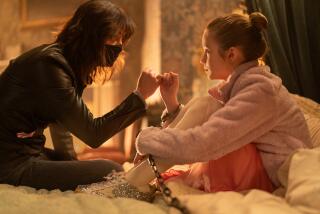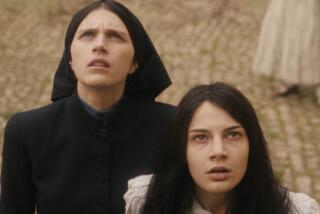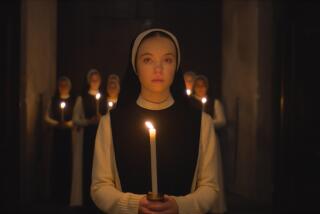Argento is man of the witching hour
When “Mother of Tears: The Third Mother” has its world premiere Thursday as the opening night film of the Midnight Madness section at the Toronto International Film Festival -- the same slot that unleashed “Borat” last year -- it will complete a trilogy of films that stretches back some 30 years for Italian director Dario Argento.
Considered a masterful maker of idiosyncratic, expressionistic horror films, at once gorgeous and grotesque, irrational and utterly perfect, the 66-year-old filmmaker’s commercial and critical standing has fallen in recent years. Preceded as it is by two of his best-regarded films, 1977’s “Suspiria” and 1980’s “Inferno,” the concluding chapter of “The Three Mothers” trilogy raises one immediate question: Why now?
“Creation is not on a schedule,” said Argento recently by telephone from Rome. “I’m a strange soul. I didn’t want to stay in the cage of the trilogy; I wanted to explore other landscapes. After ‘Inferno’ I thought, ‘Not now.’ And then three years ago I had an idea, like a trumpet in my ear, and I thought, ‘OK, now I want to finish the trilogy.’ ”
“It’s a question I’ve repeatedly asked him,” said Alan Jones via e-mail, as to what drove the filmmaker to finally complete the trilogy. Author of a book on the filmmaker, “Profondo Argento,” Jones visited the “Mother of Tears” shoot.
“I got the feeling he was ready to broach the subject matter again because he wanted to restore his tarnished reputation. . . . It might also be because he finally wants to draw a line under it and stop the endless questions about it.”
In “Mother of Tears,” the discovery of an ancient urn sets in motion a Second Age of Witches, an apocalyptic end times complete with rampaging covens of glamorously decadent witches, waves of suicides and chaos in the streets. Only a young woman who discovers that her own deceased mother was a white witch, and that she has powers of her own, can bring a stop to the mounting pandemonium.
For fans of the director, “Mother of Tears” may come to represent both a career-capping victory lap and a new beginning. Although the film can very much be seen as a return to form for Argento, it also puts new twists on his filmmaking. Rather than the strictly storybook fantasy world of “Suspiria” or “Inferno,” the new film is a heady mix of rough-hewn, street-level realism and the boldly stylized set-pieces of Argento’s signature works.
There has been a fair amount of online nail-biting among Argento watchers over the outcome of the film, as there are concerns its reception may tarnish the standing of the previous trilogy films.
“I was filled with trepidation,” Midnight Madness programmer Colin Geddes said of his feelings before seeing “Mother of Tears.” “I invited a friend along as a second opinion, and we kept turning to each other, ‘Can you believe what you just saw?’ It’s really a return to his roots in a lot of respects. It’s like watching a glorious Italian horror film from the late ‘70s and early ‘80s. There are scenes where the audience is going to totally freak out.”
Perhaps part of what has brought out the best in Argento is the participation of his daughter, Asia Argento, who stars in the film, as well as Asia’s mother, Daria Nicolodi. All three have notoriously tempestuous relationships, and neither Asia Argento nor Nicolodi have appeared in one of Dario’s films for many years. The return of Nicolodi in particular is significant for completing the trilogy as she was the co-writer of “Suspiria” and one of the lead actresses in “Inferno.”
Argento’s films have always been family affairs. The director’s earliest films were produced by his father, Salvatore, and his brother Claudio is a producer on “Mother of Tears.” Claudio’s son Nilo is also an assistant director on the film.
Asia Argento emerged as the dark diva of the art house at this year’s Cannes Film Festival, where her roles in three films earned her much press and praise from critics, including many who called her “the queen of Cannes.” In particular, her appearance in Abel Ferrara’s “Go Go Tales” -- in which as part of a stripper routine she tongue kisses a Rottweiler -- is already the stuff of Cannes infamy. “Mother of Tears” returns her to the family fold for the first time since having achieved her own international acclaim.
“We had a bit of a falling out for a few years,” Asia Argento said of her father, “and I told him as soon as I knew he was doing it that I wanted to be in the movie. I knew this was the best thing for our relationship. We don’t bring any of the stuff that’s unresolved on the shoot, so when we’re shooting movies we are in complete harmony and don’t want to spoil these great moments with stuff that is less important, the mundane stuff, life stuff, which is less important than making a movie that will last forever. What Sunday lunches are for most families is making movies for us.”
In “Mother of Tears,” Asia Argento’s character is beset by witches, dumped in a pool of rotting bodies, has a nude shower scene and is chased by an evil little monkey. It is tough to imagine American directors such as Steven Spielberg or Ron Howard subjecting their own daughters to such torments, and yet Dario Argento shrugs off the suggestion that his relationship with Asia as father-daughter and director-performer is complicated.
“Many people talk about that,” he says. “ ‘How can you kill your daughter?’ But, no. She is an actress. This is a film, and she knows very well it is a film. She was born in a family of artists.”
Asia Argento, however, allows that filming the “sexual stuff,” particularly when younger, did leave an impression. “Swimming through a swamp of corpses is easy compared to having to take my bra off when I was 16.”
Far from preparing to retire, Argento seems energized by “Mother of Tears,” and he recalled with impish delight the details of shooting the film’s finale in catacombs beneath Rome.
“We were shooting something,” Lee Wilson, consulting producer and visual effects supervisor on the film, recalled of one particularly graphic moment, “and without going into specifics of what it was, I reacted to it, and he turned to me and said, ‘Too much?’ He knows when he’s going to get a strong reaction, but if that weren’t the case, then we wouldn’t have been making a Dario Argento film.”
More to Read
The biggest entertainment stories
Get our big stories about Hollywood, film, television, music, arts, culture and more right in your inbox as soon as they publish.
You may occasionally receive promotional content from the Los Angeles Times.







